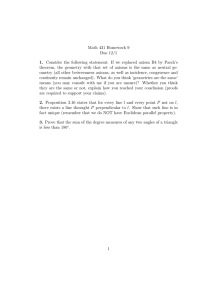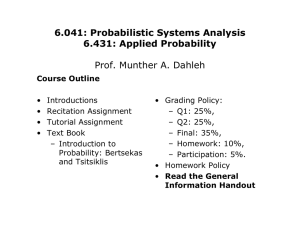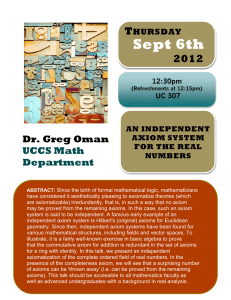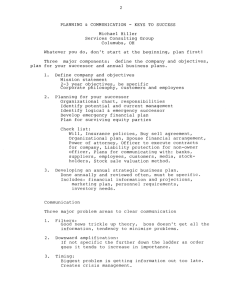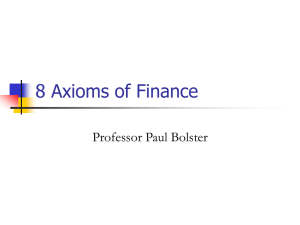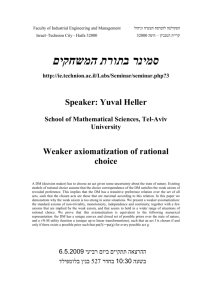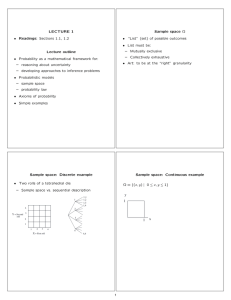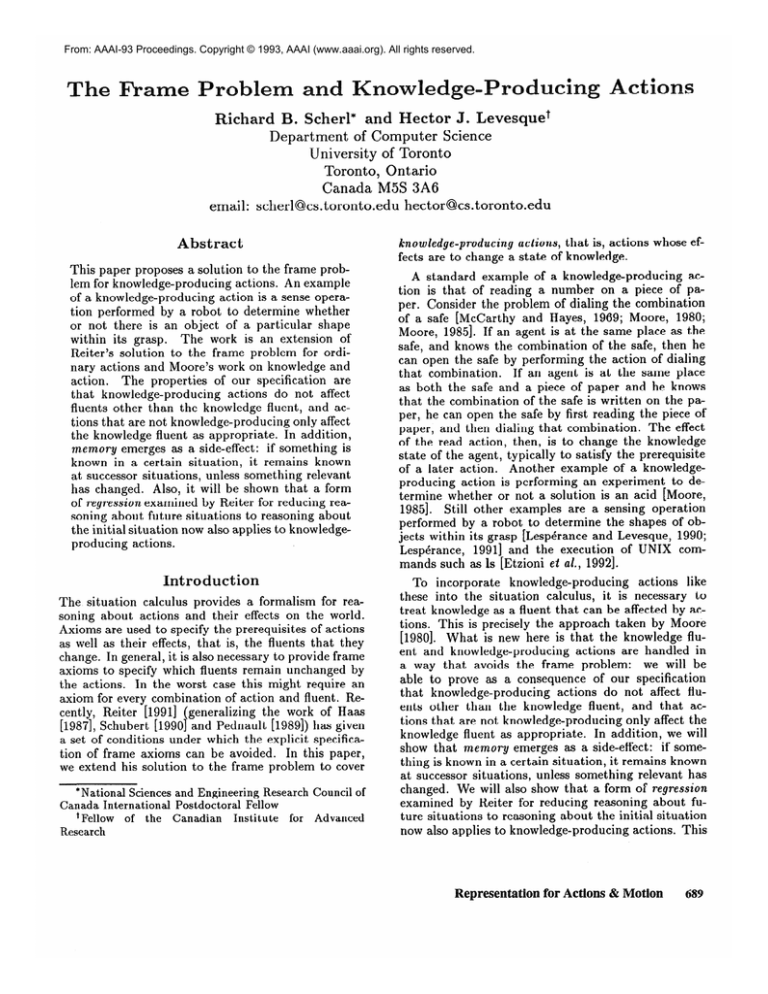
From: AAAI-93 Proceedings. Copyright © 1993, AAAI (www.aaai.org). All rights reserved.
ame Proble
Richard
email:
B. Scherl* and Hector J. Levesquet
Department of Computer Science
University of Toronto
Toronto, Ontario
Canada M5S 3A6
scherl@cs.toronto.edu
hector@cs.toronto.edu
Abstract
knowledge-producing
actions, that is, actions
fects are to change a state of knowledge.
This paper proposes a solution to the frame problem for knowledge-producing
actions. An example
of a knowledge-producing
action is a sense operation performed by a robot to determine whether
or not there is an object of a particular
shape
within its grasp.
The work is an extension
of
Reiter’s solution to the frame problem for ordinary actions and Moore’s work on knowledge and
action.
The properties
of our specification
are
that knowledge-producing
actions do not affect
fluents other than the knowledge fluent, and actions that are not knowledge-producing
only affect
the knowledge fluent as appropriate.
In addition,
memory emerges as a side-effect:
if something is
known in a certain situation,
it remains known
at successor situations,
unless something relevant
has changed.
Also, it will be shown that a form
of regression examined by Reiter for reducing reasoning about future situations to reasoning about
the initial situation now also applies to knowledgeproducing actions.
A standard example of a knowledge-producing
action is that of reading a number on a piece of paper. Consider the problem of dialing the combination
of a safe [McCarthy
and Hayes, 1969; Moore, 1980;
Moore, 19851. If an agent is at the same place as the
safe, and knows the combination
of the safe, then he
can open the safe by performing the action of dialing
that combination.
If an agent is at the same place
as both the safe and a piece of paper and he knows
that the combination
of the safe is written on the pa,
per, he can open the safe by first reading the piece of
paper, and then dialing that combination.
The effect
of the read action, then, is to change the knowledge
state of the agent, typically to satisfy the prerequisite
of a later action.
Another example of a knowledgeproducing action is performing an experiment
to determine whether or not a solution is an acid [Moore,
19851. Still other examples are a sensing operation
performed by a robot to determine the shapes of objects within its grasp [Lesperance and Levesque, 1990;
of UNIX comLesperance,
19911 and the execution
mands such as Is [Etzioni et al., 19921.
Introduction
The situation calculus provides a formalism for reasoning about actions and their effects on the world.
Axioms are used to specify the prerequisites
of actions
as well as their effects, that is, the fluents that they
change. In general, it is also necessary to provide frame
axioms to specify which fluents remain unchanged by
the actions.
In the worst case this might require an
axiom for every combination
of action and fluent. Recently, Reiter [1991] (generalizing
the work of Haas
[1987], Schubert [1990] and Pednault [1989]) has given
a set of conditions under which the explicit specification of frame axioms can be avoided.
In this paper,
we extend his solution to the frame problem to cover
*National Sciences and Engineering Research
Canada International
Postdoctoral
Fellow
‘Fellow
of the
Canadian
Institute
for
Research
Council
whose ef-
of
Advanced
To incorporate
knowledge-producing
actions
like
these into the situation
calculus,
it is necessary
to
treat knowledge as a fluent that can be affected by actions. This is precisely the approach taken by Moore
[1980]. What is new here is that the knowledge fluent and knowledge-producing
actions are handled in
a way that avoids the frame problem:
we will be
able to prove as a consequence
of our specification
that knowledge-producing
actions do not affect fluents other than the knowledge fluent, and that actions that are not knowledge-producing
only affect the
knowledge fluent as appropriate.
In addition, we will
show that memory emerges as a side-effect:
if something is known in a certain situation, it remains known
at successor situations,
unless something relevant has
changed. We will also show that a form of regression
examined by Reiter for reducing reasoning about future situations to reasoning about the initial situation
now also applies to knowledge-producing
actions. This
Representation
for Actions& Motion
689
has the desirable effect of allowing us to reduce reasoning about knowledge and action to reasoning about
knowledge in the initial situation,
where techniques
such as those discussed in [Frisch and Scherl, 1991;
Scherl, 19921 can be used.
Finally, we show that if
certain useful properties of knowledge (such as positive introspection)
are specified to hold in the initial
state, they will continue to hold automatically
at all
successor situations.
In the next section, we briefly review the situation
calculus and Reiter’s solution to the frame problem. In
the following section, we introduce an epistemic fluent
into the situation calculus as an accessibilit
relation
over situations, as done by Moore[1980;
1985 s . Our solution to the frame problem for knowledge producing
actions, based on this epistemic fluent, is developed
and illustrated over the next four sections. In the next
to the last section, we consider regression for the situation calculus with knowledge-producing
actions.
Finally, future work is discussed in the last section.
The Situation
Calculus and the Frame
Problem
The situation calculus (following the presentation
in
[Reiter, 19911) is a first-order language for representing dynamically
changing worlds in which all of the
changes are the result of named actions performed by
some agent. Terms are used to represent states of the
world-i.e.
situations.
If CYis an action and s a situation, the result of performing
cv in s is represented
by do(cr,s).
The constant Se is used to denote the
initial situationl.
Relations whose truth values vary
from situation to situation, called jhents,
are denoted
by a predicate symbol taking a situation term as the
last argument.
For example, Broken (x, s) means that
object 2 is broken in situation s.
It is assumed that the axiomatizer has provided for
Act ion Precondition
Poss(a(Z),
An action precondition
given below.
Poss(drop(x),
Axiom
s) E 7rra(Z,s)
axiom
(1)
for the action
s) E HoZding(x,
s)
drop is
(2)
Furthermore,
the axiomatizer
has provided for each
fluent F, two general
eflect axioms of the form given
1 By convention, single lower case letters (i.e. roman),
possibly with subscripts or superscripts, are used to represent variables, strings of letters beginning with a capital
letter are used for predicate symbols, strings of lower case
letters are used for function symbols, and possibly subscripted strings of letters beginning with a capital letter
are used for constants. When quantifiers are not indicated,
the variables are implicitly universally quantified.
690
Scherl
in 3 and 4.
General
Positive
Effect
Axiom
Poss(a, s) A r,‘(u,s)
General
Negative
Effect
4
for Fluent
F(do(a,s))
Axiom
Poss(a, s) A y; (a, s) -
F
for Fluent
lF(dO(U, s))
(3)
F
(4
Here 7: (a, s) is a formula describing under what conditions doing the action a in situation s leads the fluent
F to become true in the successor situation
do(a, s)
and similarly y~(u, s) is a formula describing the conditions under which performing
action a in situation
s results in the fluent F becoming false in situation
do(u, s).
For example, 5 is a positive effect axiom for the fluent
Broken.
Poss(u, s) A [(u = drop(y) A Fragile(y))
V((3b)u = explode(b) A Nexto(b, y, s))]
+ Broken (y, do(u, s))
Sentence
6 is a negative
(5)
effect axiom for broken.
Poss(u, s) A a = repair(y)
-+ lBroken( y, do(u, s))
(6)
It is also necessary to add the frame axioms that
specify when fluents- remain unchanged.
The frame
problem arises because the number of these frame axioms in the general case is 2 x A x ,T, where A is the
number of actions and F is the number of fluents.
The solution to the frame problem [Reiter,
1991;
Pednault,
1989; Schubert,
19901 rests on a completeness assumption.
This assumption
is that axioms 3
and 4 characterize
all the conditions under which action a can lead to R becoming - true (respectively,
false)
in the successor situation.
Therefore, if action a is passible and R’s truth value changes from false to true as
a result of doing a, then yi(u,s)
must be true and
similarly for a change from true to false.
Additionally, unique name axioms are added for actions and
situations.
s h ows how to derive a set of successor
Reiter[l991]
state axioms of the form given in 7 from the axioms
(positive effect, negative effect and unique name) and
the completeness
assumption.
Successor State Axiom
Poss(u,
s) -
[F(do(a,
s)) z
r,‘(%4 v (F(s) A 1YF(a, s))l
(7)
Similar successor state axioms may be written for functional fluents.
A successor state -axiom is needed for
each fluent F, and an action precondition
axiom is
needed for each action a. The unique name axioms
as their effects can
need not be explicitly represented
be compiled. Therefore only F+d axioms are needed.
From 5 and 6 the following successor state axiom for
Broken is obtained.
Poss(u, s) - [Broken(y, do(u, s)) z
a = drop(y) A Fragile(y) V (3b)a = explode(b)
ANexto(b, y, s) V Broken(y, s) A a # repair(y)]
(8)
Now note for example that if -Broken( Ob&., So), then
it also follows (given the unique name axioms) that
-Broken( Objl, do( drop(Objz), So)).
This discussion has assumed that there are no ramifications, i.e., indirect effects of actions. This can be
ensured by prohibiting state constraints,
i.e., sentences
that specify an interaction
between fluents. An example of such a sentence is VsP(s) ++ Q(s). The assumption that there are no state constraints
in the axiomatization of the domain will be made throughout
this
paper.
In [Lin and Reiter,
19931, the approach discussed in this section is extended to work with state
constraints
by compiling the effects of the state constraints into the successor state axioms.
An Epistemic
Fluent
The approach we take to formalizing knowledge is to
adapt the standard possible-world model of knowledge
to the situation calculus, as first done by Moore[1980].
Informally,
we think of there being a binary accessibility relation over situations,
where a situation s’ is
understood as being accessible from a situation s if as
far as the agent knows in situation s, he might be in
situation s’. So something is known in s if it is true in
every s’ accessible from s, and conversely something is
not known if it is false in some accessible situation.
To treat knowledge as a fluent, we introduce a binary
relation K(s’, s), read as “s’ is accessible from s” and
treat it the same way we would any other fluent. In
other words, from the point of view of the situation
calculus, the last argument to Ii’ is the official situation
argument (expressing
what is known in situation s),
and the first argument is just an auxiliary like the y in
Broken( y, s).~
We can now introduce
the notation
Knows(P, s)
(read as P is known in situation s) as an abbreviation
for a formula that uses K. For example
Knows(Broken(
y), s) def V’s’ K(s’, s) +
Broken(
y, s’).
Note that this notation supplies the appropriate situation argument to the fluent on expansion (and other
conventions are certainly possible).
This notation can be generalized inductively to arbitrary formulas so that, for example
3sKnows(3y[Nezto(z,
y) A -Broken(y)],
s) def
3xVs’ fqs’, s) + 3y[Nexto(x,
y, s’) A lBroken(y,
s’)].
We will however restrict our attention
to knowledge
about atomic formulas in both this and the next section.
Turning now to knowledge-producing
actions, there
are two sorts of actions to consider: actions whose effect is to make known the truth value of some formula,
and actions to make known the value of some term.
2 Note that using this convention means that the arguments to K are reversed from their normal modal logic use.
In the first case, we might imagine a Sensep
action
for a fluent P, such that after doing a Sensep,
the
truth value of P is known.
We introduce the notation Kwhether(P,
s) as an abbreviation
for a formula
indicating that the truth value of a fluent P is known.
Kwhether(
P, s) dgf Knows(
P, s) v Kmws(
1 P, s),
It will follow from our specification
in the next section
that Kwhether(
P, do(Sensep,
s)). In the second case,
we might imagine an action Reudt for a term t, such
that after doing a Readl, the denotation oft is known.
For this case, we introduce the notation
fined as follows:
Kref(t,
s) def %Knows(t
= x, s)
where x does not appear in t.
It will follow from the specification
developed in the
next section that Kref(t,
do( Readt, s)). For simplicity,
we assume that each type of knowledge-producing
action is associated with a characteristic
fluent or term
in this way.
Solving
the Frame Problem
The approach
being developed here rests on the spec-ification of a successor state axiom for the I< relation.
For all situations do(u, s), the Ii’ relation will be completely determined by the I< relation at s and the action a.
For non-knowledge-producing
actions (e.g. drop(x)),
the specification
(based on Moore [1980; 19851) is as
follows:
Poss(drop(x),
s) + K(s”, do( drop(x), s)) G
3s’(K(s’,s)
A (s” = do( drop(x) , s’)))
(g)
The idea here is that as far as the agent at world s
knows, he could be in any of the worlds s’ such that
K(s’, s). At do( drop(x), s) as far as the agent knows,
he can be in any of the worlds do( drop(x), s’) for any
s’ such that I<(s’, s). So the only change in knowledge
that occurs in moving from s to do( drop(x), s) is the
knowledge that the action drop has been performed.
Now consider
the simple case of a knowledgeproducing action Sensep that determines
whether or
not the fluent P is true (following Moore [1980; 19851).
Poss(Sensep,
s) + IC(s”, do(Sensep,
s)) z
[Ys (K(s’, s) A (s” = do( Sensep, s’)))
A (P(s) E P(s’))]
(10)
Ag ain, as far as the agent at world s knows, he
could be in any of the worlds s’ such that IC(s’, s).
s) as far as the agent knows, he can
At do(Sensep,
be in any of the worlds do(Sensep,
s’) for all s’
such that K(s’, s) and P(s)
E P(s’).
The idea
here is that in moving from s to do(Sensep,
s),
the agent not only knows that the action Sensep
has been performed
(as above), but also the truth
value of the predicate
P.
Observe that the successor state axiom for P guarantees
that P is true at
Representation for Actions & Motion
691
do(Sensep, s) iff P is true at s, and similarly for s’ and
do(Sensep,
s’). Therefore,
P has the same truth value
in all worlds s” such that K(s”, do(Sensep,
s)), and so
Kwhether(P,
do( Sensep, s)) is true.
In the case of a Rea& action that makes the denotation of the term t known, P(s) * P(s’) is replaced
by t(s) = t(s’).
Th ere f ore, t has the same denotation
in all worlds s” such that K(s”, do( Rea&, s)), and so
Kref(t, do(Readt, s)) is true.
In general, there may be many knowledge-producing
actions.
Each knowledge-producing
action Ai will
have associated
with it a formula (pd(s, s’).
In the
case of a Sense type of action, the formula is of the
form Fi(s)
zz Fi(s’),
where R’i is a fluent.
In the
case of a Read type of action, the formula is of the
w h ere ti is a situation-dependent
form (ti(s) = ti(s’)),
term. Assume that there are n knowledge-producing
actions Al, . . . , A, and therefore n associated formulas
The form of the successor state axiom for
(Pl~*--,(PnIi’ is then as follows:
Successor State Axiom for K
Poss(a,s)
---f K(s”,do(a,
s)) E
[3s’ (K(s’, s) A (s” = do@, s’))) A
(11)
v ((a =
4
A %)>>I
The relation K at a particular situation do(u, s) is completely determined by the relation at s and the action
U.
Example
Consider the example of opening a safe whose combination is written on a piece of paper (adapted from
Moore[1980], but without the frame axioms). The successor state axiom for the fluent Open (i.e. be open)
is:
Poss(u, s) + [Open(y, do(a, s)) E
(3xu = did(x, y) A x = comb(y,
‘@pen
The preconditions
the handle) are:
s))
(12)
(Y, s) A a # lock(~))]
for dial (actually
dialing and pulling
Poss(diul(x,
y), s) z Safe(y,
s) A
At(y, s) A (%‘K(s’,
s) + x = comb(y,
s’))
(13)
The idea here is that the object being dialed needs
to be a safe, the agent needs to be at the safe,
and the agent needs to know the combination
of
the safe.
The axiomatization
of the initial state
includes
Safe(Sfl,
SO),
At(Sfl,
SO)),
At(Ppr, SO),
Note that
and info(Ppr,
SO) =
comb(Sf1,
SO).
GlxPoss(diul(x,
Sfi), So).
It is assumed that there
are successor state axioms for Safe, At and the functional fluents info and comb.
692
Scherl
There is a knowledge-producing
the following action precondition
Poss(reud(x),
action read(x),
axiom:
s) E At(x, s)
The successor state axiom for K is as follows:
Poss(u, s) 3 K(s”, do@, s)) =
3s’(K(s’,
s) A (s” = do(u, s’))) A
((a # read(x)) V (31: (a = reud(x))
A (info(x,
s) = inf o(x, s’))))
Note that the axiomatization
entails:
I-ref(info(Ppr),do(reud(Ppr),SO))A
info(Ppr,
do(read(Ppr),
SO)) =
comb(Sf1,
do(read(Ppr),
SO))
with
(14)
(15)
(16)
Since the successor state axioms ensure that a read action does not change At, Safe, Comb and Info, it is
the case that ZlxPoss(diuZ(x, Sfl), do(reud(Ppr),
So))
the
axiomatization
entails
that
and
therefore
ElxOpen(Sfl,
do(diul(x, Sfi), do(reud(Ppr),
SO))).
Correctness
of the Solution
theorem
shows
that
knowledgeThe
following
producing actions do not change the state of the world.
The only fluent whose truth value is altered by a
knowledge-producing
action is I<.
Theorem
1 (Knowledge-Producing
Effects)
For all fEuents P (other than IC) and all knowledge
producing actions a, if P(s) then P(do(u, s)).
Proof: Immediate from having successor state axioms
Cl
for each fluent.
It is also necessary to show that actions only affect
knowledge in the appropriate
way. The truth of the
following theorem ensures that there are no unwanted
increases in knowledge.
Theorem
2 (Default Persistence
of Ignorance)
If lKnows(P,
s) then -Knows(P,
do(u, s)) unless
Poss(u, s) and either a is an Ai and P is the correspending ‘pi in the successor state uxio m for I< , 0rP
is a fluent whose successor state axiom specifies that it
is changed by action a.
I
Proof: For lKnows(P,
s) to be true, it must be the
case that Vs’K(s’,s)
4 P(s’) is false.
There must
be some s’ such that P(s’) is false. By sentence 11,
for all situations s” such that K(s”, do(u, s)), it is the
case that s” = do(u,s’) for some s’ such that K(s’,s).
Since P(s’) is false for some s’, P(do(u, s’)) will (by the
successor state axiom for P) also be false, unless either
(1) the successor state axiom for P specifies that the
effect of a is to make P true, Poss(u, s) is true, and
the conditions for this change are satisfied in s, or (2) a
is a knowledge-producing
action Ai, the corresponding
cpi in the successor state axiom for K is P(s) c--+P(s’),
P(s) is true, and Poss(u,s).
If neither is the case
by the successor state axiom for K, there will be an
s” such that K(s”, do(u, s)) where P(s”) is false and
cl
therefore ~Knows(P, do(u, s)) will be true.
Finally, it is a property of this specification
that
agents never forget.
Theorem 3 (Memory)
For all fluents
tions s, if Knows(P,
s) then Knows(P,
less the e$ect of a is to make P false.
P and situudo(u, s)) un-
The proof is similar to that of the previous theorem.
Consider again the successor state axiom for broken
given in sentence 8. If Knows(lBroken(Obji),
So) is
then
true,
Knows(lBroken(Obji),
do(drop(Ob&),
So)) must also
be true. Also, note that if Knows( Frugile( Obj,), So)
and Knows(Poss(drop(Objz)),
So) are true,
then
must also
Knows( Broken( Obj,), do( drop( Obj,), Se))
be true.
Knowledge
of Formulas
Up to this point, all results have been stated in terms
of fluents. But both the argument to Kwhether
and
Knows can be an arbitrary formula.
nothing
In the discussion
of sense type actions,
hinged on the argument to Kwhether being a fluent,
rather than a formula. Thus the effect of a sense action
performed by a robot [Lespkrance and Levesque, 1990;
Lesperance,
19911 may be specified as follows:
Kwhether(%c
(Object(x)
A 4Yolding(x)
A Ofshupe(x,
Shupel)))
(17)
Now the formula cpi associated with each knowledgeproducing action is of the form &i(s) E cy;(s’), where
oi is a formula.
Also, the arguments
to the Knows operator may
be arbitrary formulas. Now, we may also want nested
Knows operators.
The situation argument of the operator is then understood contextually.
If it is not the
outermost operator, the situation argument is understood to be the first argument of the immediately dominating I< atom. For example, 18 is understood as an
abbreviation
for 19.
Knows(Knows(P))
VSl
qs1,
So)
---f (V’s2 Iqs2,
(18)
Sl)
+
P(s2))
(19)
By a simple induction on the size of formulas, Theorems 1, 2, and 3 expressed in terms of fluents, can
be generalized to formulas as well. So, the solution to
the frame problem for knowledge-producing
actions is
correct for knowledge understood as the knowledge of
arbitrary sentences.
The only remaining issue concerns requiring that the
Knows operator conform to the properties of a particular modal logic. For example, if the logic chosen is
S4, then we want positive introspection
(sentence 20)
to be a property of the logic.
Knows(d)
--f Knows( Knows( 4))
(20)
Restrictions
need to be placed on the Ii’ relation so
that it correctly models the accessibility
relation of a
particular modal logic. The problem is to do this in
a way that does not interfere with the successor state
axioms for li’, which must completely specify the I<
relation for non-initial
situations.
The solution is to
axiomatize the restrictions for the initial situation and
then verify that the restrictions
are then obeyed at all
situations.
The sort Init is used to restrict variables to range
only over Se and those situations
accessible from So.
It is necessary to stipulate that:
Init
-+ (I<(s,sl)
+
lInit(sl)
+ (IC(s,sl)
+
Init
llnit(do(a,
Init(
iInit(s))
s))
The various restrictions
are listed below.3 The reflexive restriction is always added as we want a modal logic
of knowledge. Some subset of the other restrictions are
then added.
eflexive
V’s1 : Init IC(sl , s1)
Euclidian
Vsl :Init, s2:Inits3:Init
I+,
Symmetric
Transitive
sl) A
Vsi:Init,
1+3,
sl)
-
IC(s3,4
s2:Init Iil(s2, q)
+
IC(sl, s2)
Vsl : Init, s2: Init, ss: Init
IC(s2, sl) A
To model the logic
include the axioms
The next step is
the initial situations
that restriction
R
tions as well.
@3,
s2) +
IC(s3,
sl)
S4, for example, one would need to
for both reflexivity and transitivity.
to prove that if the I< relation over
satisfies a particular restriction R,
will also hold over the other situa-
Theorem
4 If the Ii’ relation on the set of initial situations is restricted to conform to some subset of the
transitive and euproperties
of reflexive, symmetric,
clidian, then the I< relation at every level will satisfy
the same set of properties.
The proof involves showing for each restriction
that if
the restriction holds for s, then it holds for do(u, s).
The significance of this theorem is that if the I< relation at the initial situation is defined as satisfying
certain conditions,
then the I< relation at all situations reachable from the initial situation also satisfies
those properties.
So, if we decide to use, for example,
the logic S4 to model knowledge, we can go ahead and
stipulate that the I< relation at the initial situation
is reflexive and transitive.
Then we are guaranteed
that the relation at all reachable situations
will also
satisfy those properties
and our model of knowledge
will remain S4, without danger of conflicting with the
successor state axiom.
Reasoning
Reiter [Reiter, 19911 develops a form of regression to
reduce reasoning about future situations to reasoning
about the initial situation.
In this section, a regression
operator is developed for knowledge-producing
actions
and applied to the problem of determining
whether
3Vs:lnit
p is an abbreviation
Representation
for Vslnil(s)
*
for Actions & Motion
q
693
or not a particular
plan satisfies a particular
property.
So given a plan, expressed
as a ground situa term built on SO with the funcation term (i.e.
tion do and ground action terms4) sgr, the question
is whether the axiomatization
of the domain F entails
G(s,,)
where G is an arbitrary sentence. Under these
circumstances,
the successor state axioms (including
11) are only used to regress the formula G(s,,).
The
result of the regression is a formula in ordinary modal
logic-i.e.
a formula where the only situation term is
SO. Then an ordinary modal theorem proving method
(e.g.
that developed
in [Frisch and Scherl,
1991;
Scherl, 19921) may be used to determine whether or
not the regressed formula holds.
In what follows, it
is assumed that the formulas do not use the fluent I<
except as abbreviated
by Knows.
The regression operator R is defined relative to a set
of successor state axioms 0. The first four parts of the
definition of the regression operator 7Zo concern ordinary (i.e. not knowledge-producing)
actions [Reiter,
1991; Pednault, 19891.
i When A is a non-fluen t atom, including eq uality
atoms, and atoms with the predicate symbol Puss,
or when A is a fluent atom whose situation argument
is a situation variable, or the situation constant So,
Ro[A] = A.
ii When F is a fluent (other
state axiom in 0 is
POSS(U, s) -
[F(xl,
than K) whose successor
. . . , xn, do@, s)) = @‘F]
(21)
then
Ro[F(b,
* * . , tn , do(a
>r))]
=
Q’F I;,‘,:::;;:;::
(22)
iii Whenever
7?.@[(3V)Wl] = (3v)7& p&3.
iv Whenever
%[Wl]
Wi and W2 are formulas,
A
R@[Wl],
%[Wl],
%[Wl
%[Wl
-
W2]
V
=
%&[W~AW2]
W2]
Ro[W1]
=
-
Ro[Wl]
=
V
R@[Wl].
Additional steps are needed to extend the regression
operator to knowledge-producing
actions.
For simplicity, it is assumed that there are only knowledgeproducing operators of type sense-Sense1
. . . Sense,.
Two definitions are needed for the specification
to follow. When 4 is an arbitrary
sentence and s a situation
term , then apply(4, s) is the sentence that results from
adding an extra argument to every fluent of 4 and inserting s into that argument position. The reverse operation apply- ’(4) is the result of removing the last
argument position’from
all the fluents in 4. v Whenever
a is not a knowledge-producing
Ro [Knows( W, do(u, s))]
Knows(upply-l(Ro(apply(W,
do@, s)))),
action,
=
s).
41t is also assumed that this plan is known to be exe[Reiter, 19911, i.e., each step is possible.
cutable
694
Scherl
=
vi Ro [Knows( W, do( Sensei, s))]
(cd4
p;ys(pi
+ W, s)) A (ipi (s) - Knows(-cpi
--)
9
In the following theorem, J= is the axiomatization
of
the domain including F$,, the successor state axioms.
Theorem
r
5 For any ground
I= %r
1
++
situation
F - 6
term sgr
k R&G(+)
The proof is based on an induction over all ground
action terms [Reiter, 19931. Each regression step preserves logical equivalence given an axiomatization
of
the form developed here (i.e. successor state axioms).
The process must terminate as every step removes the
outer do from the situation terms and the number of
do function symbols making up any such term is finite. Since each step preserves equivalence, the whole
process results in an equivalent formula.
The result means that to test if some sentence G
is true after executing a plan, it is only necessary to
first regress G(s,,),
where sgr is the plan expressed
as a situation term, using the successor state axioms.
This is accomplished by repeatedly passing the regression operator through the formula until the only situation term is SO. Then the successor state axioms
(including 11) are no longer needed. At that point an
ordinary modal logic theorem proving method can be
utilized to perform the test to determine whether or
not F - Fss b R*,G(s,,).
Consider
the following
example
adapted
from
[Moore, 19851 (but without the frame axioms).
The
task is to show that after an agent performs a litmus
paper test on an acidic solution, the agent will know
that the solution is acidic. The litmus paper turns red
if and only if the solution is acidic. The axiomatization
includes Acid($).
The actions are Test1 and SenSeR.
As the action preconditions
are all True, the predicate
here. The successor
Poss is ignored in the presentation
state axiom for Red is given below:
“~$$-$y~’
ca s
a = Testl)
V (Red(s)
The instance of the successor
I{ relation is:
Vu, s, s”,
do(u, s)) G
s) A (s” = do(u, s’))) A
#
SenSeR)
A (Red(s)
The formula
(23)
axiom (11) for the
K(s”,
3s’(K(s’,
((a
state
A a # Testl)
v
to be initially
Knows( Acid, do( SenseR,
Step vi of the definition
((U
=
SenSeR)
(24)
z Red( s’))))
regressed
is
do( TestI, SO)))
(25)
of R is used with 25 to yield 26.
(Red( do( TestI, SO)) ---f
Knows( Red + Acid, do( TestI, SO))) A
(TRed( do( TestI, So)) --)
Knows(lRed
----fAcid, do( TestI, SO)))
m-9
This is then regressed to sentence 27 by steps iii, iv,
and v of the regression definition along with 23.
(Acid($)
+ Knows(Acid
-+ Acid, So)) A
(lAcid(So)
+ Knows(lAcid
---t Acid, So))
(27)
Sentence 27 is clearly entailed by Acid(&)
and so 25
is entailed by the original theory.
Note that 27 can
be rewritten as a sentence in an ordinary modal logic
because the only situation term is So.
Conclusion
This paper provides a solution to the frame problem
for knowledge-producing
actions. As long as the conditions needed for Reiter’s solution for ordinary actions
can be met, the work presented here provides a solution for knowledge-producing
actions as well.
In terms of future work, we are extending the work
discussed here so that the knowledge prerequisites and
effects of actions can be indexical rather than objective
knowledge. Following [Lespkrance and Levesque, 1990;
Lesperance,
19911, this will be done by making situations a composite of agents, times and worlds.
Also, the consideration
of logics of beliefis a topic for
future research. The results presented in this paper are
limited to logics of knowledge-logics
with a possible
world semantics in which the accessibility relation is reflexive. Note that in the case of a knowledge-producing
action a that causes P to be known at do(a,s),
there
must be a situation s’ such that l<(s’,s),
and P(s’).
But in the case of a belief-producing
action, there is
no guarantee that such a situation
s’ exist.
This is
why the results do not directly extend to modal logics
without a reflexive accessibility
relation.
Acknowledgments
We thank Ray Reiter and Fangzhen Lin for useful discussions on the situation calculus and the frame problem. Additionally,
we would like to thank both Ray
Reiter and Sheila McIlraith for comments on an earlier
version of this paper. This research was funded in part
by the National Sciences and Engineering
Research
Council of Canada, and the Institute for Robotics and
Intelligent Systems.
References
Etzioni, Oren; Hanks, Steve; Weld, Daniel; Draper,
Denise; Lesh, Neal; and Williamson,
Mike 1992. An
approach to planning with incomplete
information.
In Nebel, Bernhard;
Rich, Charles;
and Swartout,
William, editors 1992, Principles
of Knowledge Representation and Reasoning:
Proceedings of the Third
International
Conference, Cambridge, Massachusetts.
115-125.
Frisch, Alan and Scherl, Richard
1991.
A general
framework for modal deduction. In Allen, J.A.; Fikes,
R.; and Sandewall,
E., editors 1991, Principles
of
Knowledge
Representation
and Reasoning:
ings of the Second International
Conference,
teo,CA : Morgan Kaufmann.
ProceedSan Ma
frame
Haas, A. R. 1987. The case for domain-specific
In Brown, F. M., editor 1987, The Frame
axioms.
Problem in Artificial Intelligence.
Proceedings of the
1987 Workshop. Morgan Kaufmann Publishers,
Inc.,
San Mateo, California.
343-348.
Lesperance,
Yves and Levesque, Hector J. 1990. Indexical knowledge in robot plans.
In Proceedings
Eighth National Conference
On Artificial Intelligence.
1030-1037.
Lesperance, Yves 1991. A Formal Theory of Indexical
Ph.D. Dissertation,
UniverKnowledge and Action.
sity of Toronto.
Lin, Fangzhen
and Reiter,
Ray 1993.
State constraints revisited.
Presented
at the Second Symposium on Logical Formalizations
of Commonsense
Reasoning.
McCarthy,
9. and Hayes, P. 1969. Some philosophical problems from the standpoint
of artificial intelligence. In Meltzer, B. and Michie, ID., editors 1969,
Machine Intelligence
4. Edinburgh
University Press,
Edinburgh,
UK. 463-502.
Moore,
action.
R.C. 1980. Reasoning about knowledge
Technical Note 191, SRI International.
and
Moore, R.C. 1985. A formal theory of knowledge and
action. In Hobbs, J.R. and Moore, R.C., editors 1985,
Formal Theories of the Commonsense
World. Ablex,
Norwood, NJ.
Pednault,
E.P.D. 1989. ADL: exploring the middle
ground between STRIPS
and the situation calculus.
In Brachman,
R.J.;
Levesque,
H.; and Reiter,
R.,
editors 1989, Proceedings
of the First International
Conference
on Principles
of Knowledge
Representation and Reasoning.
Morgan Kaufmann
Publishers,
Inc., San Mateo, California.
324-332.
Reiter, Raymond 1991. The frame problem in the situation calculus:
A simple solution (sometimes)
and
In Lifa completeness
result for goal regression.
schitz, Vladimir,
editor 1991, Artificial Intelligence
and Mathematical
Theory of Computation:
Papers
in Honor of John McCarthy.
Academic
Press, San
Diego, CA. 359-380.
Reiter, R. 1993. Proving properties of states in the
to appear.
situation calculus. Artificial Intelligence.
Scherl, Richard 1992. A Constraint Logic Approach
Ph.D. Dissertation,
To Automated Modal Deduction.
University of Illinois.
Schubert, L.K. 1990. Monotonic solution of the frame
problem in the situation calculus: an efficient method
for worlds with fully specified actions.
In Kyberg,
H. E.; Loui, R.P.; and Carlson, G.N., editors 1990,
Knowledge Representation
and Defeasible Reasoning.
Kluwer Academic Press, Boston, Mass. 23-67.
Representation
for Actions & Motion
695

